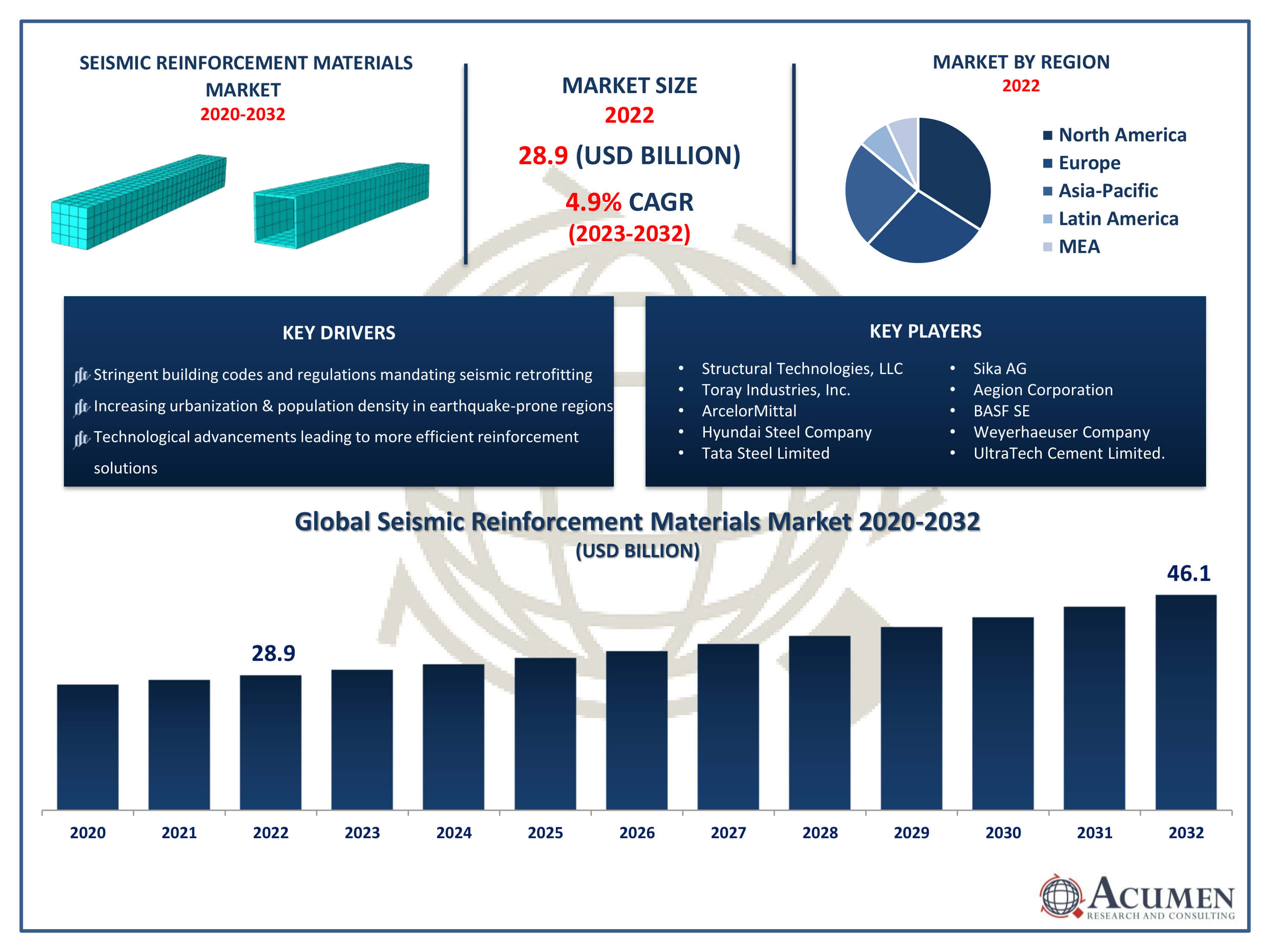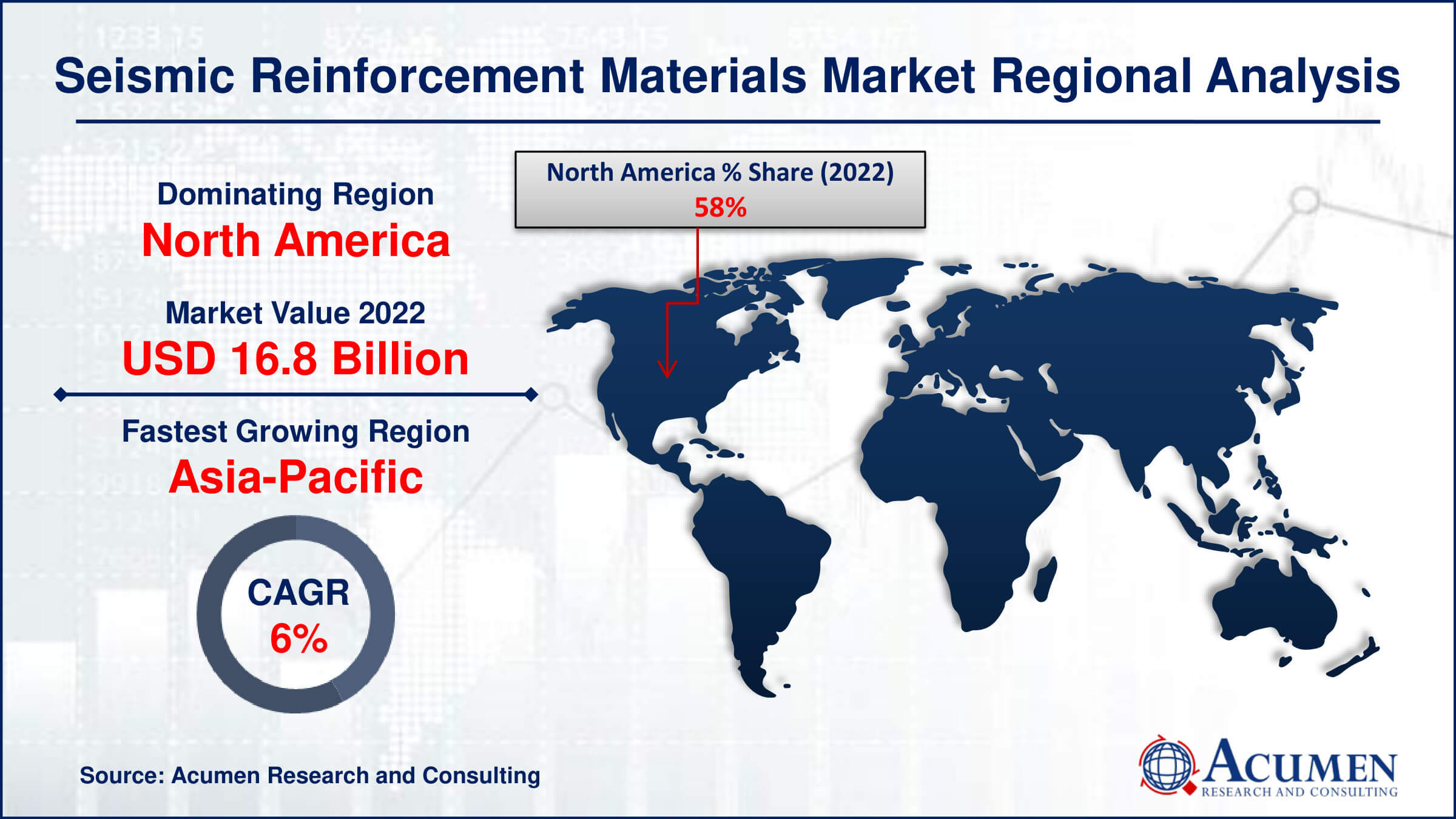October 2024
Seismic Reinforcement Materials Market Size accounted for USD 28.9 Billion in 2022 and is projected to achieve a market size of USD 46.1 Billion by 2032 growing at a CAGR of 4.9% from 2023 to 2032.
The Seismic Reinforcement Materials Market Size accounted for USD 28.9 Billion in 2022 and is projected to achieve a market size of USD 46.1 Billion by 2032 growing at a CAGR of 4.9% from 2023 to 2032.
Seismic Reinforcement Materials Market Highlights

Seismic reinforcement materials are substances or components utilized in construction to enhance the structural integrity of buildings and infrastructure against seismic events, such as earthquakes. These materials are designed to mitigate the effects of ground motion by providing additional support, strength, and flexibility to structures, thereby reducing the risk of damage or collapse during seismic activity. Common seismic reinforcement materials include steel reinforcements, fiber-reinforced polymers (FRPs), concrete additives, base isolators, and damping systems.
The market for seismic reinforcement materials has experienced steady growth in recent years, driven primarily by increasing awareness of seismic risks and stringent building codes in earthquake-prone regions. Governments and regulatory bodies are imposing stricter guidelines for construction practices, mandating the use of seismic reinforcement materials to enhance building resilience. Additionally, urbanization and population growth in seismically active areas have spurred investments in infrastructure development and retrofitting projects, further fueling market demand. Technological advancements, such as the development of innovative reinforcement materials and construction techniques, are also contributing to market expansion by offering more efficient and cost-effective solutions for seismic protection.
Global Seismic Reinforcement Materials Market Trends
Market Drivers
Market Restraints
Market Opportunities
Seismic Reinforcement Materials Market Report Coverage
| Market | Seismic Reinforcement Materials Market |
| Seismic Reinforcement Materials Market Size 2022 | USD 28.9 Billion |
| Seismic Reinforcement Materials Market Forecast 2032 | USD 46.1 Billion |
| Seismic Reinforcement Materials Market CAGR During 2023 - 2032 | 4.9% |
| Seismic Reinforcement Materials Market Analysis Period | 2020 - 2032 |
| Seismic Reinforcement Materials Market Base Year |
2022 |
| Seismic Reinforcement Materials Market Forecast Data | 2023 - 2032 |
| Segments Covered | By Material, By Application, By Product, By End-Use, And By Geography |
| Regional Scope | North America, Europe, Asia Pacific, Latin America, and Middle East & Africa |
| Key Companies Profiled | Structural Technologies, LLC, Simpson Strong-Tie Company Inc., Toray Industries, Inc., ArcelorMittal, Hyundai Steel Company, Tata Steel Limited, Sika AG, Aegion Corporation, BASF SE, Weyerhaeuser Company, UltraTech Cement Limited., and West Fraser Timber Co. Ltd. |
| Report Coverage |
Market Trends, Drivers, Restraints, Competitive Analysis, Player Profiling, Covid-19 Analysis, Regulation Analysis |
Seismic reinforcement materials refer to a range of construction materials and techniques utilized to enhance the structural integrity of buildings and infrastructure, particularly in regions prone to seismic activity. These materials aim to mitigate the impact of earthquakes by strengthening existing structures or incorporating reinforcement measures during construction. Common seismic reinforcement materials include steel braces, carbon fiber wraps, reinforced concrete elements, and base isolators. Each material is chosen based on its ability to absorb and dissipate seismic forces, thereby reducing the risk of structural damage and ensuring the safety of occupants. The applications of seismic reinforcement materials are diverse and crucial for ensuring the resilience of various types of structures. In new construction projects, these materials are integrated into the building design to meet stringent seismic codes and standards. For existing structures, seismic retrofitting involves the addition of reinforcement elements to improve their ability to withstand seismic events.
The seismic reinforcement materials market has been experiencing significant growth in recent years, driven by several key factors. One of the primary drivers is the increasing awareness of the importance of seismic resilience in infrastructure, particularly in regions prone to earthquakes. Governments and regulatory bodies worldwide have been implementing stricter building codes and standards, mandating the use of seismic reinforcement materials in both new construction and retrofitting projects. This regulatory push has significantly expanded the market by creating a strong demand for seismic retrofit solutions. Moreover, rapid urbanization and population growth in seismic-prone areas have further fueled the demand for seismic reinforcement materials. As cities expand and become more densely populated, the need to protect existing structures and infrastructure against earthquake damage becomes paramount. This trend has led to increased investment in seismic retrofitting projects, driving the growth of the market.
Seismic Reinforcement Materials Market Segmentation
The global seismic reinforcement materials market segmentation is based on material, application, product, end-use, and geography.
Seismic Reinforcement Materials Market By Material
According to the seismic reinforcement materials industry analysis, the composites segment accounted for the largest market share in 2022. Composites, such as carbon fiber wraps and fiber-reinforced polymers (FRP), offer unique advantages in seismic retrofitting and reinforcement applications. These materials are lightweight, high-strength, and corrosion-resistant, making them ideal for strengthening existing structures without adding significant weight or altering the appearance of the building. One of the primary drivers of growth in the composites segment is the increasing adoption of advanced materials in construction practices. As awareness of the benefits of composites for seismic retrofitting grows, engineers and contractors are increasingly turning to these materials to enhance the seismic resilience of buildings and infrastructure. Additionally, technological advancements in composite manufacturing processes have led to improvements in cost-effectiveness and performance, further driving market growth.
Seismic Reinforcement Materials Market By Application
In terms of applications, the bridge & flyover segment is expected to witness significant growth in the coming years. Bridges and flyovers are critical components of transportation infrastructure, often subjected to significant seismic stresses, especially in regions prone to earthquakes. As governments and transportation authorities prioritize the safety and resilience of these structures, there has been a growing demand for seismic reinforcement materials to enhance their ability to withstand seismic events. One of the key drivers of growth in this segment is the increasing investment in infrastructure development projects globally. With aging bridge and flyover infrastructure in many regions, there is a pressing need for retrofitting and rehabilitation to ensure structural integrity and safety. Seismic reinforcement materials such as carbon fiber wraps, steel braces, and base isolators offer effective solutions to strengthen existing structures and mitigate the risk of damage during earthquakes.
Seismic Reinforcement Materials Market By Product
According to the seismic reinforcement materials market forecast, the rebar & rod segment is expected to witness significant growth in the coming years. Rebars and rods are essential components in the construction industry, commonly used to reinforce concrete structures, including buildings, bridges, and infrastructure, against seismic events. With the increasing emphasis on earthquake-resistant construction practices worldwide, there has been a growing demand for high-quality reinforcement materials like rebars and rods. One of the primary drivers of growth in this segment is the surge in construction activities, particularly in regions prone to seismic activity. Urbanization, population growth, and infrastructure development projects have propelled the demand for seismic-resistant structures, necessitating the use of robust reinforcement materials. Additionally, stringent building codes and regulations in earthquake-prone regions mandate the incorporation of seismic reinforcement measures in construction projects, further driving the adoption of rebars and rods for seismic retrofitting and new construction.
Seismic Reinforcement Materials Market By End-Use
Based on the end-use, the residential segment is expected to continue its growth trajectory in the coming years. As urbanization continues to drive population growth in earthquake-prone regions, there's an increasing need to ensure the safety and resilience of residential structures against seismic events. This has led to a surge in demand for seismic reinforcement materials in the construction and retrofitting of residential buildings to meet stringent safety standards and building codes. Furthermore, heightened awareness among homeowners and developers about the risks posed by earthquakes has prompted proactive measures to reinforce residential structures. This includes retrofitting older homes with seismic reinforcement materials and integrating these materials into the construction of new residential developments. Governments and regulatory bodies in many seismic-prone regions have also introduced incentives and subsidies to encourage the adoption of seismic retrofitting and reinforcement measures in residential buildings, further driving market growth.
Seismic Reinforcement Materials Market Regional Outlook
North America
Europe
Asia-Pacific
Latin America
The Middle East & Africa

Seismic Reinforcement Materials Market Regional Analysis
North America stands out as a dominating region in the seismic reinforcement materials market. The North America region's growth is characterized by a high level of seismic activity, particularly along the Pacific Coast and in areas surrounding the San Andreas Fault in California. This heightened seismic risk has led to stringent building codes and regulations mandating seismic retrofitting and reinforcement measures, driving significant demand for seismic reinforcement materials in both new construction and retrofitting projects. Moreover, North America boasts a robust construction industry with a strong focus on infrastructure development and urbanization. As cities expand and populations grow, there is an increasing need to ensure the safety and resilience of buildings and infrastructure against seismic events. This has led to substantial investments in seismic retrofitting projects for bridges, buildings, and other critical infrastructure, further fueling the demand for seismic reinforcement materials. Furthermore, technological advancements and innovation in the region's construction and material science industries have contributed to the development of advanced seismic reinforcement solutions.
Seismic Reinforcement Materials Market Player
Some of the top seismic reinforcement materials market companies offered in the professional report include Structural Technologies, LLC, Simpson Strong-Tie Company Inc., Toray Industries, Inc., ArcelorMittal, Hyundai Steel Company, Tata Steel Limited, Sika AG, Aegion Corporation, BASF SE, Weyerhaeuser Company, UltraTech Cement Limited., and West Fraser Timber Co. Ltd.
Looking for discounts, bulk pricing, or custom solutions? Contact us today at sales@acumenresearchandconsulting.com
October 2024
November 2022
September 2022
November 2024